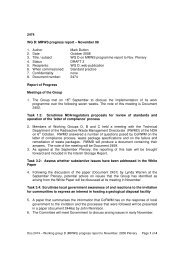2009 Report to Government on National Research and
2009 Report to Government on National Research and
2009 Report to Government on National Research and
- TAGS
- corwm.decc.gov.uk
You also want an ePaper? Increase the reach of your titles
YUMPU automatically turns print PDFs into web optimized ePapers that Google loves.
field, water availability (possibly low in a highly compacted ben<str<strong>on</strong>g>to</str<strong>on</strong>g>nite buffer or an<br />
evaporite geology) <strong>and</strong> generati<strong>on</strong> of hydrogen as an electr<strong>on</strong> d<strong>on</strong>or. In any<br />
event, the microbial community will certainly not return <str<strong>on</strong>g>to</str<strong>on</strong>g> its pristine state. Thus,<br />
microbial processes represent major uncertainties in the performance of a GDF.<br />
A.97 While many aspects of a GDF’s microbial ecology will be site specific, there<br />
remains a requirement <str<strong>on</strong>g>to</str<strong>on</strong>g> c<strong>on</strong>duct generic research <strong>and</strong> build essential capability,<br />
for example in techniques for the sampling <strong>and</strong> characterisati<strong>on</strong> of subsurface<br />
microbial communities, which are technically very difficult (Pedersen, 2002); the<br />
ecology of high pH, anaerobes <strong>and</strong> thermophiles; or the ecology of radioactive,<br />
hydrogen-rich systems.<br />
Temporal Evoluti<strong>on</strong> of Geosphere<br />
A.98 Temporal evoluti<strong>on</strong> of the geosphere is poorly unders<str<strong>on</strong>g>to</str<strong>on</strong>g>od over timescales of <strong>on</strong>e<br />
hundred <str<strong>on</strong>g>to</str<strong>on</strong>g> <strong>on</strong>e milli<strong>on</strong> years. Direct experimental observati<strong>on</strong>s <strong>and</strong> human<br />
induced perturbati<strong>on</strong>s (e.g. effects of oil <strong>and</strong> gas extracti<strong>on</strong> or mining) are all<br />
based <strong>on</strong> short time periods of less than 100 years (often substantially less),<br />
whereas observati<strong>on</strong>s of geosphere evoluti<strong>on</strong> based <strong>on</strong> geological analogues are<br />
<strong>on</strong> l<strong>on</strong>g timescales (10 thous<strong>and</strong> <str<strong>on</strong>g>to</str<strong>on</strong>g> 100 milli<strong>on</strong> years).<br />
A.99 Temporal evoluti<strong>on</strong> of the geosphere will potentially produce significant changes<br />
in groundwater chemistry, regi<strong>on</strong>al groundwater gradients, rock hydraulic<br />
properties, geochemical properties (including mineralogical surfaces for<br />
adsorpti<strong>on</strong>), mechanical loading, microbial ecology <strong>and</strong> sea level. Evoluti<strong>on</strong> of the<br />
geosphere may involve gradual change such as mineralisati<strong>on</strong> of fracture<br />
surfaces causing a gradual decrease in local permeability <strong>and</strong> increase in<br />
mechanical strength, or may be much more rapid as result, for example, either of<br />
climate change causing rapid global temperature change or of earthquake<br />
activity. Iso<str<strong>on</strong>g>to</str<strong>on</strong>g>pe geochemistry can provide data <strong>on</strong> evoluti<strong>on</strong> of past geochemical<br />
envir<strong>on</strong>ments (over 100 <str<strong>on</strong>g>to</str<strong>on</strong>g> <strong>on</strong>e milli<strong>on</strong> year timescales). However, it is not<br />
possible <str<strong>on</strong>g>to</str<strong>on</strong>g> determine from these data the rate of individual mineralisati<strong>on</strong><br />
episodes (e.g. short episodic pulses of rapid fluid movement versus c<strong>on</strong>stant time<br />
averaged flow rates); there is also no clear basis for using such data <str<strong>on</strong>g>to</str<strong>on</strong>g> predict<br />
the future.<br />
A.100 To better characterise geosphere evoluti<strong>on</strong> <strong>and</strong> reduce uncertainty in model<br />
predicti<strong>on</strong>s, CoRWM believes that a fundamental mechanistic underst<strong>and</strong>ing is<br />
required of the processes governing physical, chemical <strong>and</strong> microbiological<br />
evoluti<strong>on</strong> of the geosphere. Further, <str<strong>on</strong>g>to</str<strong>on</strong>g> validate such models, new field analogues<br />
should be sought that illuminate the role of individual processes in geosphere<br />
evoluti<strong>on</strong> <strong>and</strong> are applicable <str<strong>on</strong>g>to</str<strong>on</strong>g> the timescales appropriate for geological disposal.<br />
Radi<strong>on</strong>uclide Movement in the Biosphere<br />
A.101 In the geological disposal c<strong>on</strong>text “biosphere” means soils, surface waters,<br />
sediments, the atmosphere <strong>and</strong> the animals <strong>and</strong> plants that live in these parts of<br />
the envir<strong>on</strong>ment, including humans. It is clear that, over the timescales of interest<br />
in geological disposal, it is not possible <str<strong>on</strong>g>to</str<strong>on</strong>g> predict how the surface envir<strong>on</strong>ment at<br />
any particular site will change, nor how plants <strong>and</strong> animals will evolve. The<br />
approach used for the purposes of developing GDF safety cases is <str<strong>on</strong>g>to</str<strong>on</strong>g> carry out<br />
calculati<strong>on</strong>s based <strong>on</strong> a range of possibilities for temporal changes in the surface<br />
CoRWM Document 2543, Oc<str<strong>on</strong>g>to</str<strong>on</strong>g>ber <str<strong>on</strong>g>2009</str<strong>on</strong>g> Page 124 of 151



